

BackStory is an Archinect series that focuses on personal experiences of well-known buildings (or cities!) from those who are closest to them: docents, owners, janitors, occupants, and others. This is the expanded view or the bonus features that we may add to the official documentation of a project. Each entry in this series is a story about the building city told from an intensely personal perspective.
Editor's note: At a time when headlines are dominated by Dubai and disaster, it's refreshing to see one of our own trying to unpack decidedly less glamorous parts of our world. In this love letter / propaganda / manifesto by Archinector Fred Scharmen , the outsider (that's you) is given a glimpse into the fullness of the contemporary American city as exemplified by Baltimore, MD. Fred's peripatetic tour of Baltimore is ultimately a plea for others to care about the places at hand. To be sure, Baltimore has its own specific cocktail of aspirations, afflictions, successes, and opportunities but more than a single mid-Atlantic city what's at stake is a way of thinking about the world.
Starting from the material evidence of the city itself, captured here in Fred's photographs, and blooming into a network of larger concerns, we find in Scharmen's love letter to Baltimore an advertisement not only for his hometown but for the position of architects as a group who are uniquely able to link up- in thoughts and actions- the material to the abstract. This perspective, the architect's perspective, is a way of thinking that retains the importance of the local without giving up the complexities of contemporary life.
Are you a Believer or a Cynic? Baltimore is a city built for a million people, with only 660,000 living in it. We're either 2/3 full or 1/3 empty: so what do you like, Potential or Decay? Depending how you break, potential means either homesteading or gentrification, decay means either romantic desolation or slow motion urban tragedy. Decide quickly, and don't forget the race and class angles, either.

Baltimore murder stats from 2007, black on the left, white on the right, source: The Baltimore Sun via flickr user Sidereal
Baltimore is Postindustrial, Multilayered, Patinated. It's made of brick. Cold in the winter, hot in the summer, Baltimore is full of colleges, nonprofits, art schools, universities, bars, but also, according to the 2000 census, over 40,000 vacant housing units. There's a lot of crime and rent is cheap. The contradictions are there in the slogans: 'Bodymore Murdaland' aka 'The City that Reads' (or 'Bleeds'). 'Stop Snitchin' or just 'BELIEVE.'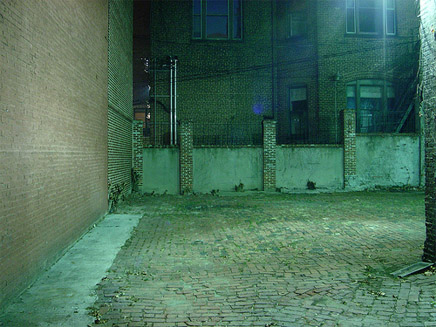
Brick alley, Baltimore
What's the proper reaction to these conditions? Resignation? Hope? Irony? Is it possible to appreciate the aesthetic consequences of Urban Decay while decrying the socio-economic forces that have produced it? Is it possible to make a living city that retains its Authenticity without producing a Monoculture?
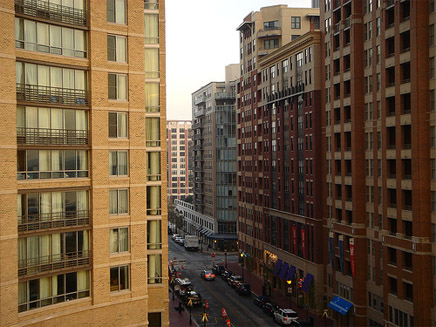
Harbor East, Baltimore
As my first studio critic used to say, whenever we asked him an either/or question: 'Yes and Yes'*.
There's no better map to the human and built geography of the city than The Wire . The alleys are all sunlit plants breaking through cracked asphalt, gantry cranes at the port swing containers off the ships with vast, cool indifference, and the vacant rowhouses are full of ghosts. But watch the interactions behind these romantic images and you'll see that the alleys are shortcuts, the containers move human cargo, and the ghosts in the vacants are real. The Wire is about the Drug War, and all the causes and consequences of same. Ignore the dope on the table, and follow the network. Watch as the same structures emerge in different systems: city government, drug gangs, labor unions, developers: rhymes, isomorphisms, patterns, diagrams. The relationship between Power and Urban Space is visible everywhere in the series. The Wire is a textbook on the Control of territory through the occupation of key nodes: the stairwells in the project towers, the courtyards in the garden apartments, the corners in the streets. Map the network, see the diagram, find the angles.
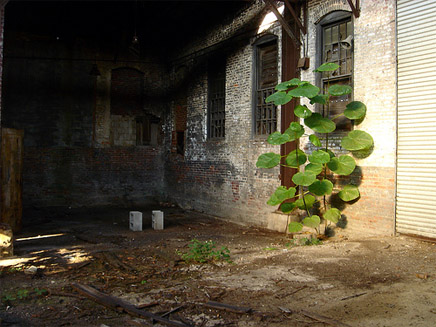
Polonia Tree in a vacant warehouse, South Baltimore
But diagnosis doesn't always lead to a cure, and cogent analysis doesn't always generate productive design: this project from Wire producer Ed Burns and others is a proposal to wall off entire city blocks for local neighborhood monitoring and policing. Everyone has a Plan. The city is moving and constantly changing. But it is small, it is comprehensible, watch and you can see Master Plans born, implemented, redirected and abandoned. The HUD Hope VI program traded large modernist public housing slabs for small scale, New Urbanist neotraditionalism, implicitly mollifying a generation of architects, planners and politicians who blame Modernism for poverty and drugs. Did the old towers fail? Is the new public space nonfunctional? Yes and Yes. Every near failure, every way that is shut, every path half taken, creates a new given: a new piece of context to deal with and integrate.
Brick wall on Saratoga St., Downtown Baltimore
The overlap of systems, networks and infrastructures creates disjunctions and gaps. It's not deconstruction, it's productive. There are opportunities in the contradictions, connections to be made, and differences to be (imperfectly) smoothed over. While surveying the old Natty Boh brewery an office I worked with found enough extra strength for five more floors of housing. Baltimore was once one of the largest ports of entry for goods, and people, into the United States. There is excess unused capacity everywhere.
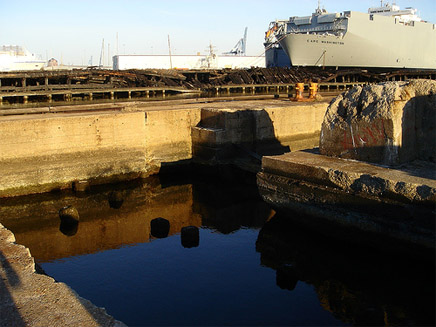
US Navy Transport Ship, Port Covington, Baltimore
From this angle, there is work here in the city that could be built nowhere else in North America, with institutional and developer clients that recognize the potential of the local and unique. Charlie Brickbauer and Ziger/Snead have built a new digital media center for Maryland Institute College of Art , a glowing shard that reaches out and mediates between warehouse, overpass, highway and trainyard. The Living Classroom Foundation continues to foster orginal, forward thinking work on the waterfront from Z/S, Alexander Design Studio , and others. Architects at Parameter Inc. are working with Turner Development Group to fill an unused grain silo on the waterfront with housing. (disclaimer: I work for one of these firms, used to work for another, and know a lot of people who work for the third. Did I mention this was a small town?)

MICA's Brown Center, Charlie Brickbauer and Ziger/Snead, photo by flickr user Idle Type
Screw globalisms, go local. Local is global at a different scale. Every emergence is just a million little totalities, every pirate is a miniature emperor, and every drug dealer is a wannabe developer. As Lester Freamon says in The Wire: "We're building something here, detective, we're building it from scratch, and all the pieces matter." I've been back in the city for seven months, and I still find, almost every week, new arts collectives, galleries, magazines, and nonprofits (see, for example: Wham City , Carroll Mansion , Locus , Parks & People ). The US headquarters of George Soros' Open Society Institute is here, and working locally. Groups like Baltimore Green Construction and the Neighborhood Design Center are moving toward a way of working in the city that is small-scale, tactical, and sustainable. Is this in marked contrast to the old Inner Harbor style of massive cash-cow development? Is this a continuation of the Inner Harbor precedent of public/private partnership and visionary change? Yes and Yes.
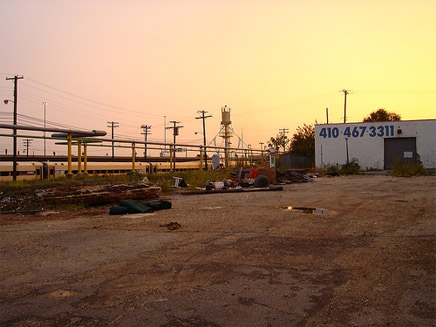
Yard, South Baltimore
Baltimore embraces Difficulty, Texture, History, and Contradiction. This is a love letter, a Manifesto, but it's also an advertisement. As a friend said the other day: "Baltimore needs architects."
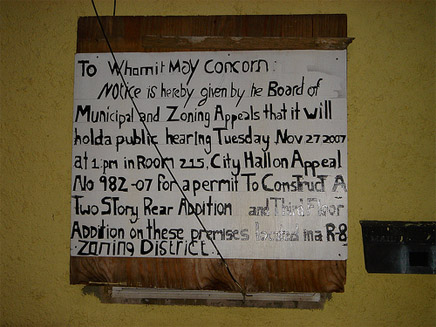
Folk Typography, South Baltimore
Fred Scharmen is a native of Baltimore who now lives and works in the city. To see more images of Baltimore, Fred invites you to view a slideshow on his Flickr page .
*Shoutout to Barney Mansavage!
Creative Commons License
This work is licensed under a Creative Commons License .
/Creative Commons License
Unlicensed Architect, Amateur Urbanist, Uncredited Designer, Sometime Researcher and Writer
13 Comments
Lovely little feature!
I spent some early years of my youth there. I still have fond memories although it has been a while since i have been back...
very nice fred! great image of a polonia tree
maybe it should be 'snitch or die' in baltimore. what would an architecture of snitches look like - an inverted panopticon or the ruins of baltimore's slums?
great series and feature. thanks to fred and bryan.
that polonia tree and the space looked very eerie, reminding some abandoned tobacco warehouses where i grew up.
What a lovely feature and yes, love letter. Thank you for doing this, 765.
That first image of the brick alley shows a city that is more compelling in its balancing of history, pragmatism, and poetry than any image that could be made anywhere in Indianapolis. Baltimore, like Philly, has historic reasons for existing that tend to both hold the city back AND make people want to move it forward.
I enjoy the Hidden Walls proposal. It's a REALLY cool sectional concept, as well as a radical approach to fixing what I think is commonly understood as the problem of inner city poverty - no community, no "village". But as radical as it is architecturally, it would need, IMO, to be backed up by some pretty radical social engineering to really work. It's a good thing to consider, though, as are all options when places become as troubled as B-more is.
Great feature, thanks for putting it out there everyone.
Wow, this is great Fred, thanks. I was wondering what those pictures on your blog were for :o)
Cheers, y'all! And cheers to Bryan., especially for that intro, but also for convincing me not to Capitalize all Nouns.
@liberty bell - I think the Hidden Walls project is interesting, but given how we've seen that space can be so easily controlled, for better or worse, by limiting and controlling access, I can't believe the people proposing it don't see the contradictions.
That polonia tree photo was taken in the building next door to mine. It's about to be knocked down for condos.
Great read, Fred. Thank you. Being a newly planted Philadelphian, I hope to get down there for a visit soon. I've only passed through Baltimore and never actually had the chance to see the city.
well written piece. Do I feel despair as an architect? (there are so many problems to solve) Am I excited to be an architect? (there are so many opportunities to imagine) Yes and yes.
Yes and Yes... seems to me like you are finding the "middle path". I like it!
Great feature Fred. The concept of the Hidden Walls project is enthralling. I would love to see it take seed in Baltimore as well as perhaps other "failing" cities throughout the US. The photos are fantastic. Thanks for sharing your thoughts and observations.
Hey Fred,
I moved from Baltimore almost a year ago. A friend here told me about this piece, and I read it with great interest, and really enjoyed the photoset on Flickr. Baltimore is small in some ways: I too worked at two of the firms you mentioned (in fact you might be sitting in my old station at ZS), and talked with CA a few times when I was working on my thesis. I also recognize the dude on the CSX bridge. Look forward to meeting you someday.
Anyway, this reminds me of the many treasures I discovered wandering through the wonderful forgotten lands of Baltimore. I just wish I was taking pictures then, cos there is so much to show, and I am afraid some of it has disappeared by now. Tough call to preserve the wasteland, or rebuild?
Thanks for the good words, guys, middle path, definitely, or maybe even both extremes at once.
MaverickMatt, it's a small town in the best way, I'll bet I know some people you know.
Block this user
Are you sure you want to block this user and hide all related comments throughout the site?
Archinect
This is your first comment on Archinect. Your comment will be visible once approved.